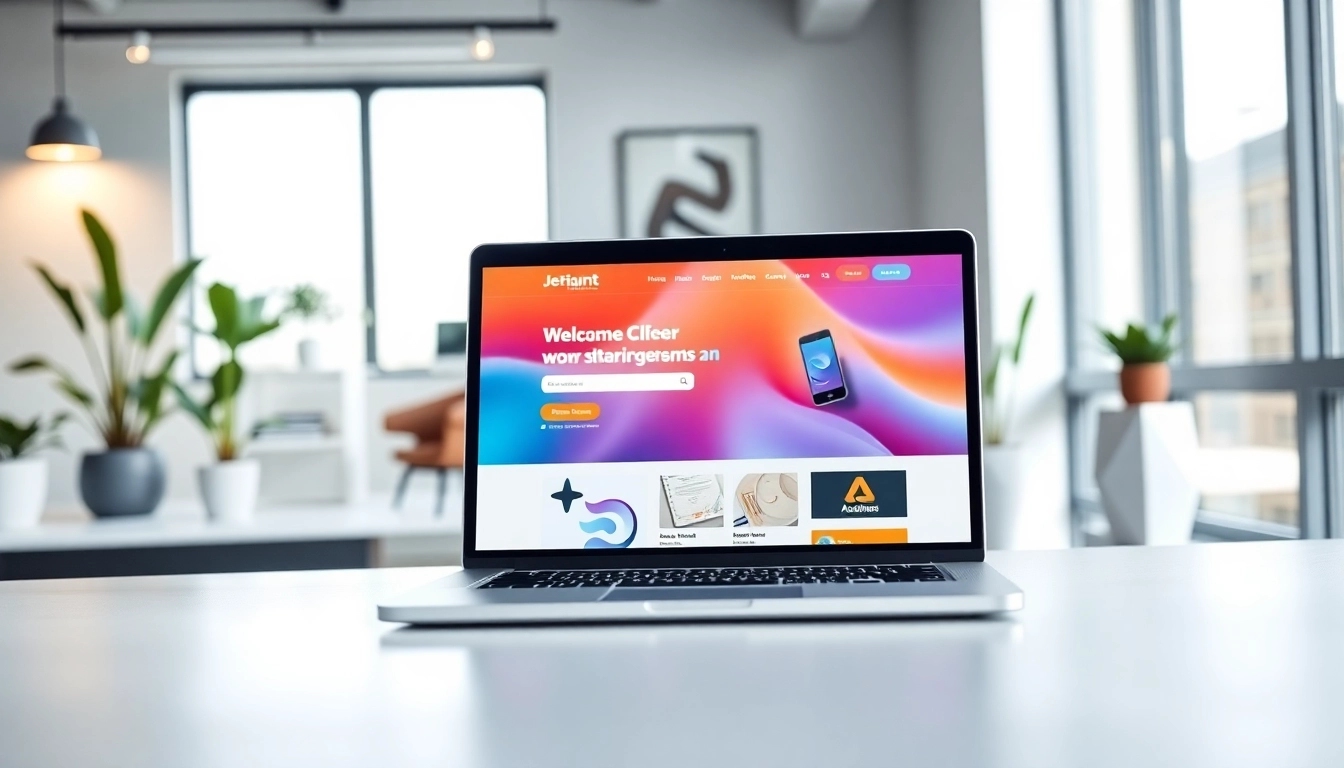Understanding the Fundamentals of Website Design
Defining Website Design and Its Importance
Website design refers to the process of planning and creating websites. This process encompasses numerous disciplines, including web graphic design, user interface design, authoring, and search engine optimization. The primary goal of website design is to create an effective and engaging digital presence that can attract and retain users. A well-designed website acts as a business card in a virtual world, helping to establish credibility and authority. Companies are now increasingly recognizing the importance of an effective web presence as a crucial component of their marketing strategies. This increasing emphasis on website design is essential in today’s highly competitive digital environment, where the first impression often determines whether users stay or leave a site.
Key Elements of Effective Website Design
Effective website design is multidimensional and includes several components that work in harmony to create an appealing and functional website. Here are some of the most critical elements:
- Visual Design: This includes color schemes, typography, images, and layout. The visual elements should not only represent the brand’s identity but also create an enjoyable user experience.
- Content: High-quality, engaging content is essential for providing value to visitors. This includes text, images, and interactive elements that communicate the brand message effectively.
- Functionality: Websites must be easy to navigate and perform well across various devices and browsers. Functionality aspects include loading time, form submissions, and integration with other tools.
- Usability: A user-centric approach ensures that websites are intuitive and straightforward to use, enabling users to find information effortlessly.
- Responsiveness: In an era where users access websites from different devices, responsive design is crucial. It ensures that the website interface adapts seamlessly to various screen sizes and resolutions.
The Role of User Experience in Website Design
User experience (UX) is at the heart of effective website design. It encompasses all aspects of end-users’ interactions with the company, its services, and its products. An excellent UX design considers the user’s journey, aiming to create a smooth, enjoyable, and efficient experience as they navigate the site. Factors influencing UX include load times, accessibility, and overall satisfaction with the site. This focus on user experience not only improves user satisfaction but also leads to higher conversion rates, as users are more likely to engage with a site that meets their needs effectively.
Exploring Different Styles of Website Design
Comparing Minimalist and Complex Designs
When considering website design styles, two prominent approaches stand out: minimalist and complex designs. Minimalist design emphasizes simplicity and clarity, focusing on essential elements without unnecessary distractions. This style is characterized by clean lines, ample white space, and limited color palettes, all of which can enhance usability and create a modern aesthetic.
On the other hand, complex designs involve more intricate layouts and may incorporate various interactive elements, such as animations and detailed visuals. While they can convey a rich brand story and engage users, complexity can sometimes lead to user overwhelm if not managed properly.
The choice between minimalist and complex designs often depends on the target audience and the objectives of the website. Understanding user preferences and behaviors is key to making an informed decision in this context.
Responsive vs. Adaptive Website Design
Responsive and adaptive designs are two common approaches to creating websites that function well across different devices. Responsive design employs a fluid grid layout that adapts dynamically to the user’s screen size, ensuring a seamless browsing experience. This approach is highly favored due to its flexibility and ability to provide consistency across devices and orientations.
In contrast, adaptive design involves creating distinct layouts for specific screen sizes. While it offers more control in terms of design and user experience, it can also increase development complexity and maintenance costs. The choice between responsive and adaptive design should be guided by strategic business objectives and user needs, ensuring both functionality and aesthetic appeal.
Trends in Modern Website Design Aesthetics
Modern website design is continuously evolving, driven by technological advancements and changing user preferences. Several trends have emerged, including:
- Dark Mode: This aesthetic has gained popularity due to its sleek appearance and reduced eye strain in low-light conditions. Many users appreciate having the option to switch between light and dark themes.
- 3D Elements: The use of three-dimensional graphics can create a visually immersive experience, captivating users’ attention and enhancing engagement.
- Custom Illustrations: Tailored illustrations offer brands a unique identity, setting them apart in a crowded marketplace.
- Micro-Interactions: Subtle animations and feedback responses enhance user interaction, making navigation feel more engaging and intuitive.
Staying updated with these design trends allows businesses to maintain relevance and appeal to a modern audience.
Essential Tools for Website Design
Graphic Design Software for Web Design
A variety of graphic design tools exist to assist web designers in creating compelling visuals. Software like Adobe Photoshop and Adobe Illustrator enables designers to craft stunning graphics and layouts, while tools like Sketch and Figma facilitate collaborative design processes. These tools are integral for creating and optimizing images, layouts, and overall user interfaces, forming the backbone of the graphic design aspect of website development.
Website Builders and Their Features
Website builders provide user-friendly platforms for creating websites without extensive coding knowledge. These tools often feature drag-and-drop functionality, customizable templates, and built-in SEO tools. Popular website builders simplify the design process, allowing users to focus more on content rather than technical challenges. They can be particularly beneficial for small businesses looking to establish an online presence quickly and effectively.
Testing and Optimization Tools for Website Design
Design is just the first step; ensuring that a website performs optimally is crucial for its success. Testing and optimization tools help identify potential issues, enhance user experience, and optimize conversion rates. Tools like Google Analytics allow designers to track user behavior, while A/B testing platforms enable experimentation with design elements to find the most effective configurations. Continuous testing and optimization are vital to adapt to changing user needs and technological advancements.
Best Practices for Effective Website Design
Creating User-Centric Website Designs
User-centric design focuses primarily on understanding and catering to the end-user’s needs. This approach involves user research and testing, enabling designers to create websites that are both functional and appealing. Engaging with users through surveys, usability testing, and feedback collection can unveil insights into their preferences, behaviors, and pain points, leading to more effective design solutions.
SEO Considerations in Website Design
SEO plays a critical role in website design as it directly influences the site’s visibility and traffic. Effective design practices must incorporate SEO strategies right from the beginning. This involves optimizing site speed, ensuring mobile-friendliness, using proper heading structures, and incorporating relevant keywords throughout the content. By designing with SEO in mind, businesses can enhance their search engine rankings and reach a broader audience.
Accessibility Considerations for Inclusivity
Designing with accessibility in mind ensures that all users, including those with disabilities, can access and navigate the website effectively. This includes using appropriate contrast ratios, providing alt text for images, and ensuring keyboard navigability. Adhering to accessibility guidelines not only legally protects businesses but also fosters inclusivity, enhancing the overall user experience for everyone.
Measuring the Success of Your Website Design
Analyzing User Engagement Metrics
To assess the effectiveness of a website design, analyzing user engagement metrics is crucial. Metrics like bounce rate, average session duration, and pages per session provide insight into user behavior on the site. High engagement typically signifies that the design resonates with users, encouraging them to explore further. Tracking these metrics over time can pinpoint areas for improvement and allow for targeted design adjustments.
Tools for Tracking Website Performance
Website performance tracking tools are essential for monitoring and evaluating a site’s functionality. Platforms like Google Analytics and SEMrush offer comprehensive insights into traffic patterns, user behavior, and site performance. These tools enable businesses to make data-driven decisions that improve user experience, optimize content, and enhance overall site effectiveness.
Iterating Based on User Feedback
Gathering and implementing user feedback is vital for continuous improvement of website design. Surveys, feedback forms, and usability tests provide invaluable information on user experience. By iterating based on this feedback, designers can refine their approach, making targeted adjustments that enhance usability and meet user needs more effectively.









